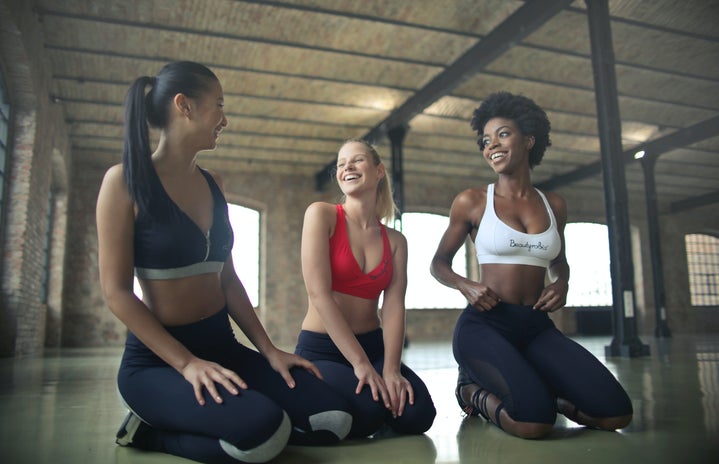The average woman produces a total of 62,415 pounds of garbage from menstrual products over her lifetime, and will spend over $18,000 (approx. GBP13,000) buying them.
It’s high time that modern women rethink the way they treat their own vaginas and mother earth herself. Both are very vulnerable and easily damaged by the products and chemicals we expose them to. Vaginas are highly absorbent, as vaginal tissue is lined with permeable mucous membranes, which protect the body from bacteria but can also easily absorb or be disturbed by other chemicals.
Many products that are used for menstrual hygiene contain harsh chemicals, such as perfumes, chlorine and bleach – not to mention the pollution caused by treating the used cotton with pesticides. Chlorine is used to whiten and disinfect cotton, but also leaves behind dioxin residues in the fibers of tampons, which are carcinogens linked to abnormal tissue growth, immune, hormonal and endocrine system disruption.
Contrary to popular belief, Toxic Shock Syndrome (TSS) is not only caused by leaving sanitary products in for too long. Small parts of fibers remain in the vaginal canal even after removing tampons, which can also become a breeding ground for bacteria, causing TSS. These problems can only truly be eliminated by reaching for alternatives.
Beyond personal health reasons, disposable menstrual products create a large amount of waste. The average woman uses 11 000 to 16 000 tampons in her lifetime, which end up in the non-recycling trash, resulting in landfill. Reusable products in particular are much more environmentally friendly, and considerably cheaper. Most of these products can be used for more than three years, given appropriate care. No more last-minute runs to the corner store for tampons, no more gross trash, and most importantly, no more harsh chemicals!
Period Underwear
In particular: THINX pants. Remember the controversial subway advertisements that people were arguing about showing grapefruits that look like vaginas and egg-whites as metaphors for discharge? Thinx is genius for having caused such viral controversy over how we advertise women’s products. I have an alternative version by MUJI which is a little cheaper and more accessible in the UK. These pants have an anti-microbial, permeable upper layer, and a thin layer underneath which absorbs, retains and prevents leakage.
How to use: You can choose from a range of different designs, which are variably suited for different strengths of flow. There is also an option to customize your own “cycle set” on the THINX website, attuned to your own different levels of flow. Then, you just pop them on and wear them throughout the day, either as main protection or back-up to prevent leakage from other products you may be using (a menstrual cup, for example).
How to clean: Once the time comes to take them off, you give them a quick rinse with cold water. After hanging them, you can wait until laundry day to run them through a normal wash cycle.
Pros: They are the most comfortable and easy option that provides leak-proof protection (up to two tampons worth) and are great as a safety net for night-time. You won’t be staining your favourite underwear anymore, and even though these are especially designed for your period, they look super cute and come in a range of styles. Plus, THINX’s marketing is off the charts beautiful and clever. Feeling like you get to treat yourself during that time of the month does wonders for your self-esteem.
Cons: On days that you experience a heavier flow, these should work but reviewers have claimed they can’t wear them throughout the whole day. Prevent this problem by picking the highest possible absorbency for each day.
Menstrual Cups
These are alternatives to other internal period products, such as tampons. There is an overwhelming diversity of different brands manufacturing menstrual cups nowadays, but only a few factors should be looked out for to ensure you are happy with your product; the rest is just marketing (some have different colour-ways, come with accessories or care kits). Make sure the cup has a decently sized neck or ring for retrieval and that it is made of medical grade silicone to ensure longevity. Ideally, it should also be BPA free (BPA can disrupt embryonic development).
How to use: Pick a size. Most brands carry two different ones: pre- and post-pregnancy, but others have “soft” options for beginners. Generally, this is a lot easier than choosing what flow you are with different brands. Wash your hands, insert it (there are instructions online and in the given packaging) and leave the cup in for up to twelve hours if it feels comfortable. Then retrieve the cup, empty it into the toilet, rinse with cold water and re-insert/dry and store.
How to clean: Rinse with cold water in between uses. Once a month I like to do a deep clean by placing the cup in boiling water for about fifteen minutes. This does not degrade or damage the silicone, but rather kills off any bacteria.
Pros: A menstrual cup holds around 1oz (30ml) of blood. This means it is safe to leave in for much longer (a whole day!) without changing than other products, as most women lose between 1 and 2oz of blood during each cycle. They can also be used continually for about 2-4 years – some even last up to 10, depending on how you take care of them. This saves you a lot of money, and the environment a lot of landfill and pollution! Travelling with a menstrual cup is incredibly easy as it is discrete and can be taken anywhere as one single thing, rather than a bunch of products with bulky packaging.
Cons: Adjusting to inserting and removing a menstrual cup in particular ways may take a little time to get used to, but is easily learned. Once you are used to using them, menstrual cups are the easiest menstrual product to use. Some women with a low-sitting cervix may struggle with these, as they may not fit as they should. There are, however, shorter versions too.
Fabric Pads
The re-usable counterpart to the disposable pads we all already know. They absorb just as well – if not better- than regular reusable pads. Plus, they can’t contain any harsh chemicals and perfumes. Similarly to period pants, these pads are reusable and washable, with a permeable and non-permeable layer to absorb and lock in.
How to use: Choose a pattern, and then place the pad onto underwear as per usual. The pad is secured on the underside of the pants using either poppers or Velcro.
How to clean: After use, give it a quick rinse with cold water, hang to dry and then pop into the laundry once the day arises.
Pros: These are great if you are uncomfortable using “internal” protection, or if you have a heavier flow and would like to switch out the inlay of your panties throughout the day. They also come in really fun colours and patterns! In contrast to disposable pads, reusable ones help maintain a natural pH balance due to their breathability, and won’t cause any chafing. The fabric pad’s top layer is usually made of cotton, making it just as comfortable as your favourite pair of underpants.
Cons: If you would like to switch these pads out during the day, you would have to purchase multiples – there are, however, pre-packaged sets to make this easier! As with any menstrual product, there is a potential of leakage, and since these are worn with “regular” underwear, you run the risk of staining them if you don’t use the pads appropriately.
The fact that we are only now widely rethinking our menstrual purchasing decisions and how they relate to our health and the environment is terrible, but unsurprising. Sanitary pad manufacturers still aren’t required to list their ingredients because the products fall under the category of “devices”. We are best equipped when taking matters into our own hands (or vaginas).


